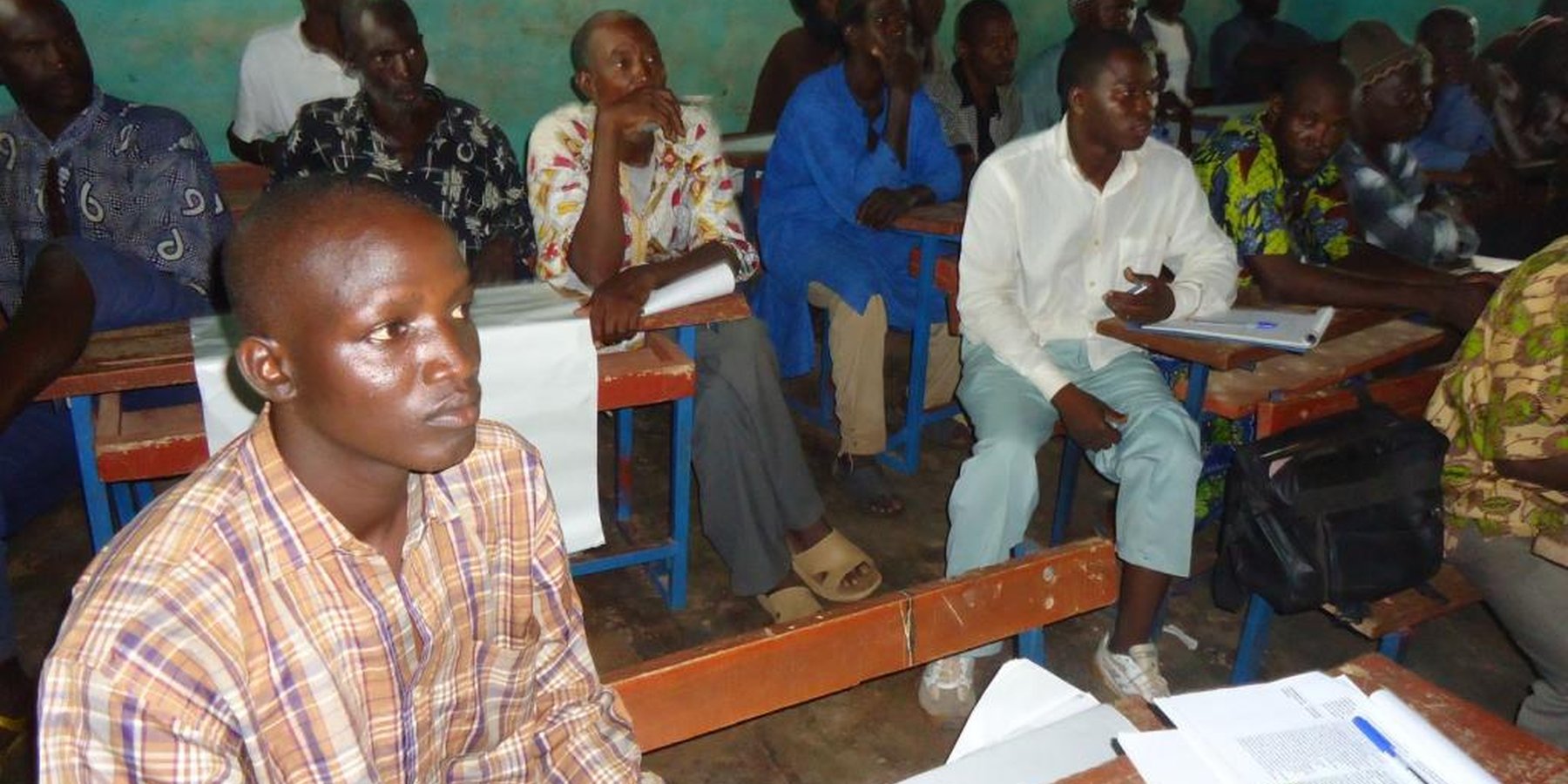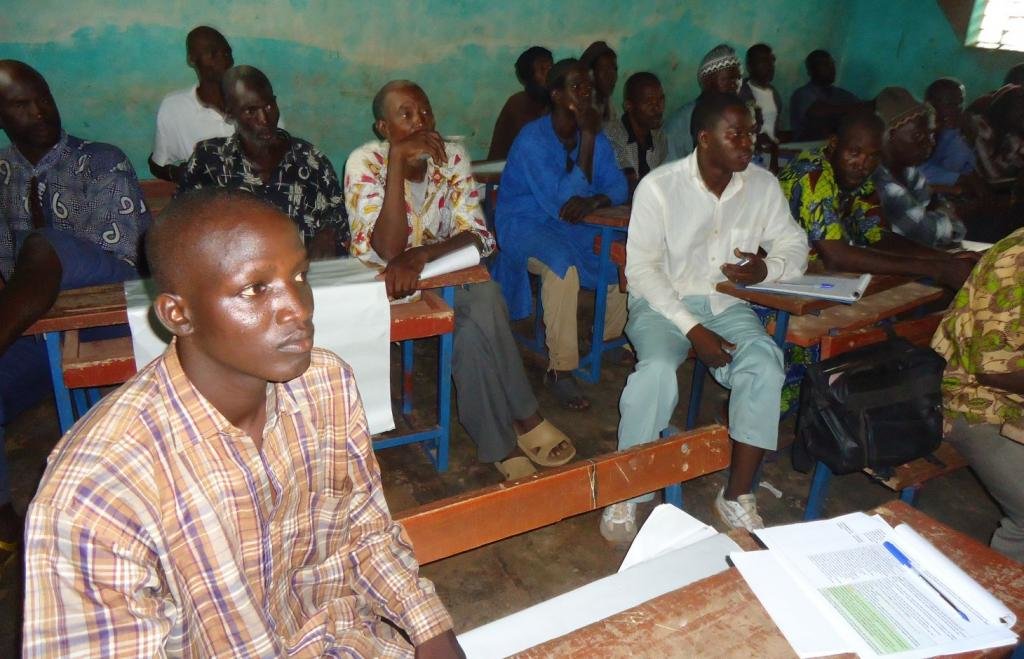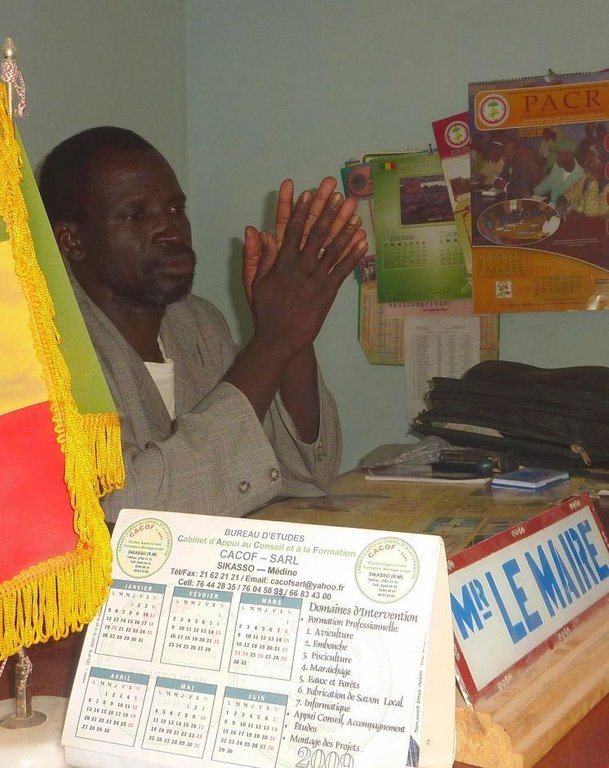Identifying and prioritizing scheme sites using a territorial, multi-stakeholder approach [Mali]
- Creación:
- Actualización:
- Compilador: Dieter Nill
- Editor: –
- Revisor: Laura Ebneter
Identification et priorisation des sites d’aménagement dans une approche territoriale multi-acteurs (French)
approaches_2499 - Mali
Visualizar secciones
Expandir todo Colapsar todos1. Información general
1.2 Detalles de contacto de las personas de referencia e instituciones involucradas en la evaluación y la documentación del Enfoque
Especialista MST:
Diallo Safiatou
safiatou.diallo@helvetas.org
Helvetas - Swiss Intercooperation
Mali
Nombre de la(s) institución(es) que facilitaron la documentación/ evaluación del Enfoque si fuera relevante)
HELVETAS (Swiss Intercooperation)Nombre de la(s) institución(es) que facilitaron la documentación/ evaluación del Enfoque si fuera relevante)
Deutsche Gesellschaft für Internationale Zusammenarbeit (GIZ) - Alemania1.3 Condiciones referidas al uso de datos documentados mediante WOCAT
¿Cuándo se compilaron los datos (en el campo)?
01/07/2012
El compilador y la/s persona(s) de referencia claves aceptan las condiciones acerca del uso de los datos documentados mediante WOCAT :
Sí
2. Descripción del Enfoque MST
2.1 Breve descripción del Enfoque
The desired objectives are to identify the priority actions for investment that have been agreed by local actors within the framework of the pastoral scheme, and to develop lowland areas.
2.2 Descripción detallada del Enfoque MST
Descripción detallada del Enfoque MST:
The approach aims (i) to ensure that all actors involved in developing lowland areas participate in the planning process and (ii) to prepare the ground for the self-management of the lowland scheme from the outset of the process. The goal is to gear the identification and prioritisation processes for schemes being carried out by local authorities (regional council, intermunicipal body, circle) towards the actual needs of local people.
This is achieved by preparing actors and organising multi-stakeholder meetings so that the visions of the different parties can be aligned in an inclusive way. This joint approach ensures investments are more relevant and well founded.
This practice was implemented in the four circles participating the AVAL programme: Kadiolo,
Sikasso, Yorosso and Koutiala. The practice led to the identification of around 10 priority investment sites in each of the four circles concerned. The sites are agricultural (dams, ponds) or pastoral (rangeland, cattle market, route marking). At the beginning of the process, the terms of reference (ToR) and data collection sheets are drawn up and presented to all the actors to ensure they are equally informed and to demonstrate the relevance of the approach across the regional council. The first workshop promotes a common understanding of the objectives and outcomes of the good practice.
Data on actual investment needs is collected by the commune (using data collection sheets) from actors in each village. An initial proposal for the identification and prioritisation criteria for scheme sites is put together by the regional council and its staff. The criteria are submitted for the approval of local actors in forums organised at the circle level with the support of the technical services. Following a first sift based on predefined criteria, the select committee judges the commitments and budgets of each and allocates scores for each criteria ranging from zero to five. Compulsory criteria (initial selection stage): 1)Absence of land ownership disputes, 2)Membership of PDESC, 3)Opening up the area – distance to a road or track that is accessible in all seasons, 4)The number of beneficiaries, 5)Farming of lowland areas–area of farmed land in relation to the possible farmable area. Optional criteria (second-stage sift for projects that have cleared the initial stage): 1)Diversification–number of products or farms, 2)Gender–number of women in relation to men, 3)Capacity of actors to contribute. On this basis, the actors from each circle identify the sites that offer the greatest potential from among the development projects undertaken by communes in the area in the context of their development programmes. Local authorities are then tasked with ensuring the supervision of the development process and the management of works and developed land. At the prioritisation workshop, each commune in the circle takes turn presenting and making the case for its completed data sheet to the plenary.
The regional council initiates the process, defines the identification and prioritisation criteria, undertakes the regional consolidation of projects for delivery at the local level and acts as mediator between communities.
The circle councils organise the information and consultation workshops and the decision-making/prioritisation workshop, and they set up the moderation team with the support of technical services.
Communes pre-select projects at the commune level, assessing them in terms of their relevance to PDESC and the criteria put forward; they ensure data collection sheets are completed in collaboration with beneficiaries, and they take part in the prioritisation process by making the case for their projects.
The support structure (AVAL) provides training and advisory support to actors.
Technical services provide technical support and make sure activities are coherent and in line with national programmes. Consultants facilitate the process and train the actors.
2.3 Fotos del Enfoque
2.5 País/ región/ lugares donde el Enfoque fue aplicado
País:
Mali
Región/ Estado/ Provincia:
Mali
Especifique más el lugar :
Kadiolo, Sikasso, Yorosso, Koutiala
2.6 Fechas de inicio y conclusión del Enfoque
Indique año del inicio:
2009
2.7 Tipo de Enfoque
- proyecto/ basado en un programa
2.8 Propósitos/ objetivos principales del Enfoque
The Approach focused mainly on SLM with other activities
The approach aims (i) to ensure that all actors involved in developing lowland areas participate in the planning process and (ii) to prepare the ground for the self-management of the lowland scheme from the outset of the process. The goal is to gear the identification and prioritisation processes for schemes being carried out by local authorities (regional council, intermunicipal body, circle) towards the actual needs of local people.
The SLM Approach addressed the following problems: lack of involvement of stakeholders in developing lowland areas
2.9 Condiciones que facilitan o impiden la implementación de la/s Tecnología/s aplicadas bajo el Enfoque
entorno institucional
- impiden
lack of involvement of stakeholders in developing lowland areas
Treatment through the SLM Approach: all actors involved in developing lowland areas participate in the planning process
3. Participación y roles de las partes interesadas involucradas
3.1 Partes interesadas involucradas en el Enfoque y sus roles
- usuarios locales de tierras/ comunidades locales
- especialistas MST/consejeros agrícolas
- ONG
HELVETAS - Swiss Intercooperation
- gobierno nacional (planificadores, autoridades)
3.2 Involucramiento de los usuarios locales de tierras/ comunidades locales en las distintas fases del Enfoque
| Involucramiento de los usuarios locales de tierras/ comunidades locales | Especifique quién se involucró y describa las actividades | |
|---|---|---|
| iniciación/ motivación | pasivo | |
| planificación | interactivo | |
| implementación | interactivo | |
| monitoreo y evaluación | pasivo | |
| Research | pasivo |
3.4 La toma de decisiones en la selección de Tecnología(s) MST
Especifique quién decidió la selección de las Tecnología/ Tecnologías a implementarse:
- principalmente por especialistas MST en consulta con usuarios de tierras
Explique:
Decisions on the method of implementing the SLM Technology were made by mainly by SLM specialists with consultation of land users
4. Apoyo técnico, fortalecimiento institucional y gestión del conocimiento
4.1 Construcción de capacidades / capacitación
¿Se proporcionó la capacitación a usuarios de tierras/ otras partes interesadas?
Sí
Especifique quién fue capacitado:
- usuarios de tierras
Forma de capacitación:
- reuniones públicas
4.2 Servicio de asesoría
¿Los usuarios de tierras tienen acceso a un servicio de asesoría?
Sí
Especifique si servicio proporcionado se realizó:
- en centros permanentes
Describa/ comentarios:
Advisory service is quite adequate to ensure the continuation of land conservation activities; The planning capacity of local authorities is strengthened, and this expertise in the planning process can be applied to other sectors
4.3 Fortalecimiento institucional (desarrollo institucional)
¿Se establecieron o fortalecieron instituciones mediante el Enfoque?
- sí, mucho
Especifique el nivel o los niveles en los que se fortalecieron o establecieron las instituciones:
- local
Especifique el tipo de apoyo:
- construcción de capacidades/ entrenamiento
4.4 Monitoreo y evaluación
¿El monitoreo y la evaluación forman parte del Enfoque?
Sí
Comentarios:
socio-cultural aspects were ad hoc monitored by project staff through observations;
economic / production aspects were ad hoc monitored by project staff through observations
management of Approach aspects were ad hoc monitored by project staff through observations
There were no changes in the Approach as a result of monitoring and evaluation
There were no changes in the Technology as a result of monitoring and evaluation
4.5 Investigación
¿La investigación formó parte del Enfoque?
Sí
Especifique los temas:
- sociología
- economía/ marketing
- tecnología
5. Financiamiento y apoyo material externo
5.1 Presupuesto anual para el componente MST del Enfoque
Si no se conoce el presupuesto anual preciso, indique el rango:
- 2,000-10,000
Comentarios (ej. fuentes principales de financiamiento/ donantes principales):
Approach costs were met by the following donors: international non-government: 100.0%
5.2 Apoyo financiero/material proporcionado a los usuarios de tierras
¿Los usuarios de tierras recibieron financiamiento/ apoyo material para implementar la Tecnología/ Tecnologías? :
No
5.3 Subsidios para insumos específicos (incluyendo mano de obra)
- ninguno
Si la mano de obra de usuarios de tierras fue un insumo sustancial, ¿fue:
- voluntario?
5.4 Crédito
¿Se proporcionó crédito bajo el Enfoque para actividades MST?
No
6. Análisis de impacto y comentarios de conclusión
6.1 Impactos del Enfoque
¿El Enfoque ayudó a los usuarios de tierras a implementar y mantener Tecnologías MST?
- No
- Sí, un poco
- Sí, moderadamente
- Sí, mucho
The planning capacity of local authorities is strengthened, and this expertise in the planning process can be applied to other sectors. Strong levels of community engagement are seen to arise. Investment decisions and funding awards are not carried out in secret deliberations or project offices. The links between the different levels in local authorities are reinforced and a shared development vision is jointly owned by all actors.
¿El Enfoque empoderó a grupos en desventaja social y económica?
- No
- Sí, un poco
- Sí, moderadamente
- Sí, mucho
Did other land users / projects adopt the Approach?
- No
- Sí, un poco
- Sí, moderadamente
- Sí, mucho
This practice was implemented in the four circles participating the AVAL programme: Kadiolo, Sikasso, Yorosso and Koutiala. The practice led to the identification of around 10 priority investment sites in each of the four circles concerned. The sites are agricultural (dams, ponds) or pastoral (rangeland, cattle market, route marking).
Did the Approach lead to improved livelihoods / human well-being?
- No
- Sí, un poco
- Sí, moderadamente
- Sí, mucho
Did the Approach help to alleviate poverty?
- No
- Sí, un poco
- Sí, moderadamente
- Sí, mucho
6.2 Motivación principal del usuario de la tierra para implementar MST
- producción incrementada
- incremento de la renta(bilidad), proporción mejorada de costo-beneficio
- improvement of well-being and livelihoods
6.3 Sostenibilidad de las actividades del Enfoque
¿Pueden los usuarios de tierras sostener lo que se implementó mediante el Enfoque (sin apoyo externo)?
- sí
6.4 Fortalezas/ ventajas del Enfoque
| Fuerzas/ ventajas/ oportunidades desde la perspectiva del compilador o de otra persona de referencia clave |
|---|
| The links between the different levels in local authorities are reinforced and a shared development vision is jointly owned by all actors. Each actor comes to understand their importance as part of the implementation of the investment programme. Moreover, strong levels of community engagement are seen to arise. Investment decisions and funding awards are not carried out in secret deliberations or project offices. |
| The moderate costs also help towards making this practice sustainable. |
|
The planning capacity of local authorities is strengthened, and this expertise in the planning process can be applied to other sectors. The inclusive approach and the local availability of facilitation skills are factors that make the practice sustainable. When outcomes are accepted by all actors, the uptake and sustainability of the practice become more likely. (How to sustain/ enhance this strength: It is essential to prepare thoroughly before beginning work: criteria must be clear and relevant; communes must describe and document their scheme propositions and back them up with appropriate arguments; and moderation teams must be objective. Ensuring actors are informed is a major factor for success: all parties have the right to timely information. Elected representatives must have a good understanding of their roles within the context of decentralisation and rural sector development; communities must be closely involved in the process. Inclusive participation requires the involvement of actors across the board. ) |
6.5 Debilidades/ desventajas del Enfoque y formas de sobreponerse a ellos
| Debilidades/ desventajas/ riesgos desde la perspectiva del compilador o de otra persona de referencia clave | ¿Cómo sobreponerse a ellas? |
|---|---|
| A major constraint in delivering this practice is the requirement that territorial communities contribute their own funds, as this forms part of the selection criteria |
7. Referencias y vínculos
7.1 Métodos/ fuentes de información
- visitas de campo, encuestas de campo
- entrevistas con usuarios de tierras
7.2 Referencias a publicaciones disponibles
Título, autor, año, ISBN:
Manual of Good Practices in Small Scale Irrigation in the Sahel. Experiences from Mali. Published by GIZ in 2014.
¿Dónde se halla disponible? ¿Costo?
http://star-www.giz.de/starweb/giz/pub/servlet.starweb
Título, autor, año, ISBN:
HELVETAS Swiss Intercooperation (2009), Rapport du forum de priorisation des investissements hydro-agricoles et pastoraux. [Report of the hydro-agricultural and pastoral investment prioritisation forum]
Título, autor, año, ISBN:
HELVETAS Swiss Intercooperation (2010), Convention du partenariat local des cercles de Kadiolo, Sikasso, Koutiala, Yorosso. [Local partnership agreement between the Kadiolo, Sikasso, Koutiala and Yorosso circles]
Vínculos y módulos
Expandir todo Colapsar todosVínculos
No hay vínculos
Módulos
No se hallaron módulos




